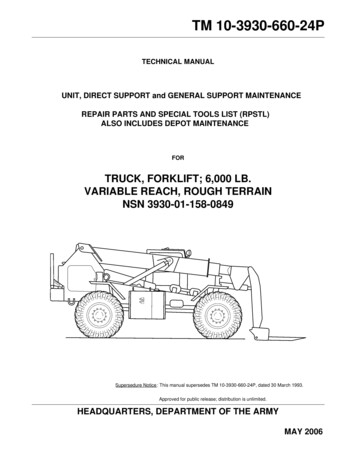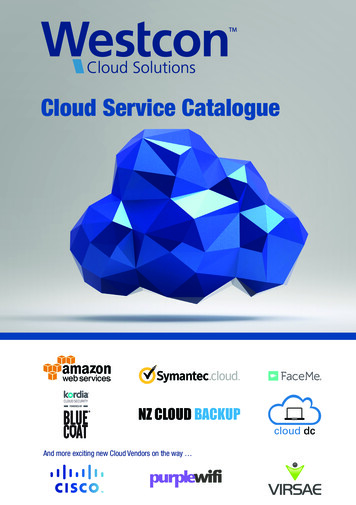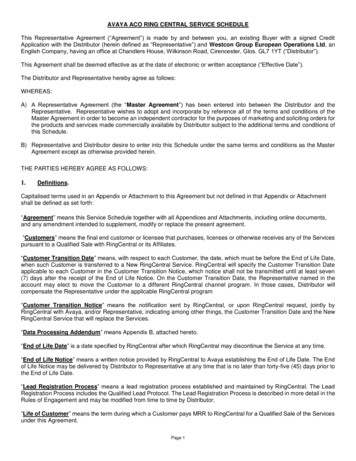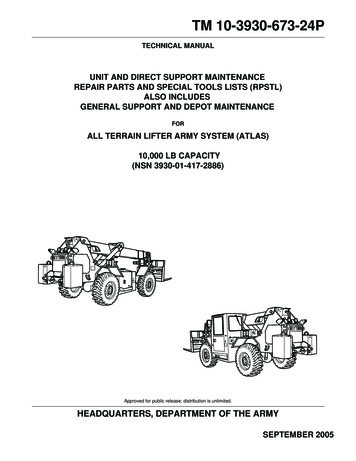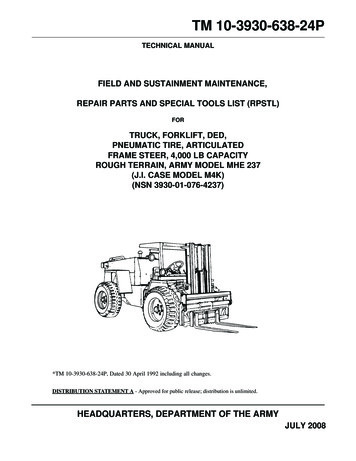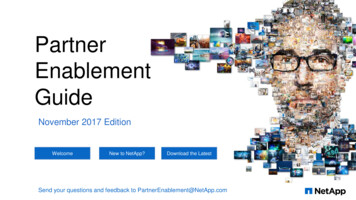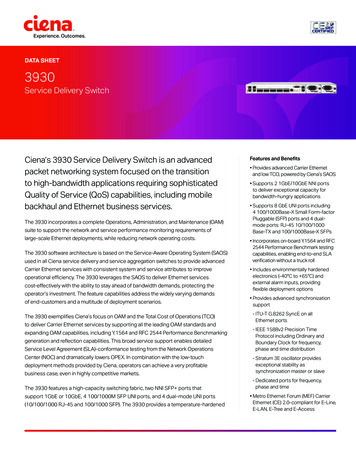
Transcription
DATA SHEET3930Service Delivery SwitchCiena’s 3930 Service Delivery Switch is an advancedpacket networking system focused on the transitionto high-bandwidth applications requiring sophisticatedQuality of Service (QoS) capabilities, including mobilebackhaul and Ethernet business services.The 3930 incorporates a complete Operations, Administration, and Maintenance (OAM)suite to support the network and service performance monitoring requirements oflarge-scale Ethernet deployments, while reducing network operating costs.The 3930 software architecture is based on the Service-Aware Operating System (SAOS)used in all Ciena service delivery and service aggregation switches to provide advancedCarrier Ethernet services with consistent system and service attributes to improveoperational efficiency. The 3930 leverages the SAOS to deliver Ethernet servicescost-effectively with the ability to stay ahead of bandwidth demands, protecting theoperator’s investment. The feature capabilities address the widely varying demandsof end-customers and a multitude of deployment scenarios.The 3930 exemplifies Ciena’s focus on OAM and the Total Cost of Operations (TCO)to deliver Carrier Ethernet services by supporting all the leading OAM standards andexpanding OAM capabilities, including Y.1564 and RFC 2544 Performance Benchmarkinggeneration and reflection capabilities. This broad service support enables detailedService Level Agreement (SLA)-conformance testing from the Network OperationsCenter (NOC) and dramatically lowers OPEX. In combination with the low-touchdeployment methods provided by Ciena, operators can achieve a very profitablebusiness case, even in highly competitive markets.The 3930 features a high-capacity switching fabric, two NNI SFP ports thatsupport 1GbE or 10GbE, 4 100/1000M SFP UNI ports, and 4 dual-mode UNI ports(10/100/1000 RJ-45 and 100/1000 SFP). The 3930 provides a temperature-hardenedFeatures and Benefits Provides advanced Carrier Ethernetand low TCO, powered by Ciena’s SAOS Supports 2 1GbE/10GbE NNI portsto deliver exceptional capacity forbandwidth-hungry applications Supports 8 GbE UNI ports including4 100/1000Base-X Small Form-factorPluggable (SFP) ports and 4 dualmode ports: RJ-45 10/100/1000Base-TX and 100/1000Base-X SFPs Incorporates on-board Y.1564 and RFC2544 Performance Benchmark testingcapabilities, enabling end-to-end SLAverification without a truck roll Includes environmentally hardenedelectronics (-40 C to 65 C) andexternal alarm inputs, providingflexible deployment options Provides advanced synchronizationsupport- I TU-T G.8262 SyncE on allEthernet ports- I EEE 1588v2 Precision TimeProtocol including Ordinary andBoundary Clock for frequency,phase and time distribution-S tratum 3E oscillator providesexceptional stability assynchronization master or slave-D edicated ports for frequency,phase and time Metro Ethernet Forum (MEF) CarrierEthernet (CE) 2.0-compliant for E-Line,E-LAN, E-Tree and E-Access
single rack unit form factor (1RU) with redundantMCPAC or DC power supply modules.Proven Service-Aware Operating SystemCiena’s SAOS delivers consistent benefits acrossall Ethernet access and aggregation applications,First Tier Ethernet/MPLS AggregationMTUTerabit Ethernet/MPLSAggregationIP/MPLSDomainincluding: Interoperability with Ethernet equipment fromother vendorsSMB Improved efficiency and cost savings resultingfrom a common deployment and serviceprovisioning modelLarge Enterprise Service offering ubiquity, permitting rapid rolloutof new services across the entire network Complete MEF-compliant Ethernet serviceMetro Aggregation(G.8032)HardenedOperator Networkofferings- E-Line (virtual and private)- E-LAN (virtual and private)Mobile Backhaul- E-Tree (virtual and private) andFigure 1. Metro packet architecture for aggregation of multiple services- E-Access (virtual and private)Sophisticated Multi-Level QoS HandlingThe 3930 implements carrier-class, MEF CE 2.0-certified QoSthat permits delivery of a wide range of traffic types and rates overa single access infrastructure without interference or degradation.These capabilities enable greater revenue generation by utilizingavailable network resources efficiently, while improving customerrelations with enforceable and reliable SLAs. These capabilitiesare enabled by: Eight hardware queues/port, up to 64 ingress meters per port Per-port, per-VLAN QoS with CIR/EIR settingsG.8032 Ethernet Ring Protection SwitchingThe 3930 supports multiple resiliency options, including G.8032Ethernet Rings. G.8032 provides deterministic 50 ms protectionswitching, enabling operators to deliver carrier-grade Ethernetservices and attain the resiliency capabilities of the legacySONET infrastructure without the associated costs. Ciena’ssolution is highly scalable, permitting the number of networkelements on the ring to increase as needs grow. Additionally, ringbandwidth can be based on 1GbE or 10GbE, and even includering spans based on other service layer technologies and speedspermitting exceptional flexibility for operators to create G.8032rings and provide sub-50 ms resiliency. Two rate Three Color Metering (trTCM), marking, policing,shaping Random Early Detection (RED), flexible Deficit Weighted RoundRobin (DWRR), and Strict Priority Scheduling Hierarchical QoS (H-QoS)The 3930 enables automated service provisioning, resultingin a more comprehensive deployment of QoS at a significantlylower cost.2
Performance Benchmarking and SLAConformance TestingIETF RFC 2544 Generator/ReflectorITU-T Y.1564 Generator/ReflectorLayer 3 SLA Monitoring & Metrics:Frame Delay, Frame Delay VariationIETF RFC 5357 TWAMPTwo-Way Active Measurement ProtocolLayer 2 SLA Monitoring & Metrics:Frame Delay, Frame Delay Variation, Frame LossITU-T Y.1731 Ethernet OAMService Heartbeats, End-to-End & Hop-by-Hopfault detectionIEEE 802.1ag CFMConnectivity Fault ManagementEnhanced troubleshooting, rapid networkdiscoveryIEEE 802.3ah EFMPhysical LinkFigure 2. 3930 OAM suiteIndustry-Leading OAM SuiteThe 3930 integrates performance benchmarking generationeffective strategy to monitor the health and performance of theswitch, enabling exceptional OPEX savings. Most mobileSuccessful Carrier Ethernet service deployments require annetwork and end-customer EVCs. The approach to OAM can makeor break the business case, as customers demand expanded SLAverification and inefficient approaches drive OPEX.Ciena’s portfolio has a strong OAM feature suite providingcomprehensive link, service, and network monitoring andand reflection capabilities directly within the service deliveryoperators and other demanding end-customers requireperformance test and characterization before serviceacceptance. Typically, this testing is performed by technicianswith expensive handheld test sets, leading to scheduling delaysand associated high OPEX costs.performance metrics. OAM features available today include:Ciena’s low-touch turn-up simplifies system turn-up and enables IEEE 802.1ag Connectivity Fault Management (CFM)minimizes service personnel costs and ensures consistent, IEEE 802.3ah Ethernet in the First Mile (EFM)reproducible test reports ready for immediate transmission to thecustomer for service acceptance. IEEE 802.1AB Link Layer Discovery Protocol (LLDP) ITU-T Y.1731 Performance Monitoring: Delay, Jitter, Loss IETF RFC 5618 TWAMP Sender and Responder forL3 SLA Monitoring IETF RFC 2544 Performance Benchmarking Test Generationand Reflection ITU-T Y.1564 Ethernet Service Activation Test MethodologySLAJitter2544 performance testing to be run from the NOC. This efficiencyA built-in test generator/reflector also empowers the operator tobe highly responsive to service disruptions. When service impactsare detected by ongoing performance monitoring tests (Y.1731 orTWAMP) or upon report by the end-customer, performance testscan be initiated immediately by the NOC; no technician schedulingis required, no trucks are rolled. Testing to isolate and localize theissue and then focus resources on addressing the specific rootcause can occur at virtually no cost. This responsiveness meanstroubles are fixed faster, minimizing service impact and creatinghigher customer satisfaction.The 3930 enhances the RFC 2544 standard by providingadditional metrics like Frame Delay Variation, including moreexpedient test suite results and architecting to the ITU-T Y.1564standard for even greater capabilities.TimeFigure 3: Proactive performance monitoring3
Synchronization and TimingFlexible Deploymentis driving the convergence of services, and placing newenabling the one platform to address a multitude of serviceThe cost-effectiveness and versatility of Carrier Ethernetnetwork synchronization requirements onto the Ethernetaccess/aggregation network. Provision of accurate frequency,phase, or time references from the Carrier Ethernet network isalso beginning to emerge as a service in its own right. The 3930includes capabilities to enable accurate and scalable deliveryand distribution of frequency, phase, and time acrossthe packet network to support applications such asLTE backhaul or synchronization as a service.3930 supports: ITU-T G.8262 Synchronous Ethernet on all Ethernet ports forfrequency distribution and reference IEEE 1588v2 Precision Time Protocol including ordinary andboundary clock support for frequency, phase and time distribution Hybrid timing distribution model using synchronous Ethernetfor frequency and PTP for phase and time A Stratum 3E oscillator for exceptional accuracy and stabilityas a timing master or slave Dedicated external BITS, GPS*, and 1pps* ports for localfrequency, phase and time referencesThe architecture of the 3930 provides flexibility to operators,applications and deployment environments without sacrificingservice feature capabilities. Extended temperature rating (-40 C to 65 C) enablesdeployment in a wide variety of locations Universal power options for DC applications ( 24/-24/ 36/-36/-48V),AC applications (100-240V) and simplex or duplex powering External alarm inputs enable the 3930 to be housed in OutsidePlant (OSP) cabinets and provide environmental monitoringincluding doors and rectifiers10G, at 1G Price PointsThe 3930 provides the ability to deploy with 1G backhaul todayand simply swap transceivers to upgrade to 10G when thecustomer needs it. This level of efficiency means no forkliftchange-outs are needed to migrate to high bandwidths, andno wasted capital investments.For operators with a predominantly 1G access network, the3930 enables a single platform deployment and tactical useof 10G where needed, plus an up-sell ability to market 10G tocurrent 1G end-customers.Blue Planet Manage, Control and Plan (MCP)Blue Planet MCP unifies network and service management withresource control and network planning to drive service agilityfor Ciena’s packet and optical networking portfolio. MCP is anopen network lifecycle operations system unifying network/service management, control, and planning in a single platformwith advanced visualization. Comprising a strategic shift awayfrom traditional fragmented network management software,MCP enables the transformation to real-time, scalable softwarecontrol, easily integrating into network operators’ businessprocesses through open APIs. It provides unified inventory andservice management across multiple technology layers, real-timemonitoring, and online planning, with the purpose of deliveringan exceptional user experience. This results in fast, streamlined,data-driven operations for informed business decisions.4
Technical InformationInterfaces2 x 1/10G SFP NNI ports4 x 100/1000M SFP UNI ports4 x 10/100/1000M RJ-45; 100/1000M SFP UNIcombo ports1 x Console Port (RJ-45, EIA-561)16 x External Alarm Inputs1 x RJ45 sync input/output port2 x mini-SMB sync input/output portsEthernetIEEE 802.3 EthernetIEEE 802.3u Fast EthernetIEEE 802.3z Gigabit EthernetIEEE 802.1D MAC BridgesIEEE 802.1Q VLANs - Including .1p PriorityIEEE 802.1ad Provider Bridging (Q-in-Q) VLAN fullS-VLAN rangeVLAN tunneling (Q-in-Q) for Transparent LANServices (TLS)Per-VLAN MAC Learning ControlPer-Port MAC Learning ControlIEEE 802.3ad Link Aggregation ControlProtocol (LACP)ITU-T G.8032 Ethernet Ring Protection SwitchingJumbo Frames to 9216 bytesLayer 2 Control Frame TunnelingMEF CE 2.0 Certified:E-LINE: EPL, EVPLE-LAN: EP-LAN, EVP-LANE-Access: Access EPL, Access EVPLE-Tree: EP-Tree, EVP-TreeMulticast ManagementRFC 2236 IGMPv2 SnoopingIGMP DomainsIGMP Message FilteringIGMP Inquisitive LeaveBroadcast/Multicast Storm ControlUnknown Multicast FilteringWell-known Protocol ForwardingQuality of Service8 Hardware Queues per-PortCommitted and Excess Information Rate(CIR and EIR)Classification based onIEEE 802.1D priorityVLAN, source port, destination port,IP Precedence and IPDSCPLayer 2, 3 Quality of ServiceIngress metering per-portIngress metering per-port per-CoSIngress metering per-port per-VLANUp to 2000 Ingress Meters per-portUp to 2048 Ingress Meters per-systemC-VLAN Priority to S-VLAN Priority MappingS-VLAN Priority based on C-VLAN IDPer-VLAN Classification, Metering, and StatisticsPer-port, per-VLAN QoS with CIR and EIRtraffic on Egress QueuesSynchronizationITU-T G.8262/G.8264 SyncEIEEE 1588v2 (OC, TC & BC)**ITU-T G.8261ITU-T G.8265/G8265.1ITU-T G.8275ITU-T G.8275.1*Stratum3E oscillatorExternal Timing Interfaces:BITS in or out (1.544MHz, 2.048MHz, 2 Mb/s)10MHz, 1.544MHz, 2.048MHz in or out1pps in or outCarrier Ethernet OAMIEEE 802.1ag Connectivity Fault Management(CFM)IEEE 802.3ah Ethernet in the First Mile (EFM)IEEE 802.1AB Link Layer Discovery Protocol(LLDP)ITU-T Y.1564 Ethernet Service Activation TestMethodologyRFC 2544 Performance Benchmarking TestGeneration and ReflectionITU-T Y.1564-compliant architectureRFC 5618 TWAMP Responder and ReceiverTWAMP SenderTWAMP /- 1ms timestamp accuracyDying Gasp with Syslog and SNMP TrapsMPLS/VPLSRFC 2205, 3031, 3036, 3985 MPLS PseudowireEmulation Edge-to-Edge (PWE3)RFC 3916, 3985, 4446, 4447, 4448 PseudowiresRFC 5654 MPLS-Transport Profile (TP)LSP Static provisioning1:1 Tunnel protectionLSP BFD via Gal/GachMPLS Virtual Private Wire Service (VPWS)RFC 4664, 4665 L2VPNsRFC 4762 VPLS (Virtual Private LAN Service) andHierarchical VPLS (H-VPLS)Provider Edge (PE-rs) Functionality for VPLS andH-VPLSPE-rs Functionality with Spoke and Mesh VirtualCircuitsMTU-s Functionality for H-VPLS deploymentMTU-s Multihoming (redundant VCs to differentPE-s switches)MPLS Virtual Circuit as H-VPLS spoke VirtualCircuitQ-in-Q Ethernet Virtual Circuit as H-VPLS spokeVirtual CircuitMPLS Label Switch Path (LSP) TunnelRedundancyLayer 2 Control Frame Tunneling over MPLSVirtual CircuitsRFC 3209 RSVP-TE (for MPLS Tunnel Signaling)RFC 3630 OSPF-TE (for MPLS Tunnel Routes)RFC 3784 IS-IS-TE (for MPLS Tunnel Routes)RFC 3036 Targeted LDP (for VPLS VC signaling)RFC 4090 MPLS Fast ReRoute (via RSVP-TE)MPLS Performance MonitoringRFC 4379 LSP PingRFC 4379 LSP TracerouteRFC 5085 LSP Ping and Traceroute extensions towork over Pseudowires (PW VCCV)Service SecurityEgress Port RestrictionIEEE 802.1X Port-Based Network AccessControl (RADIUS/MD5)Layer 2, 3 Protocol FilteringBroadcast ContainmentUser Access RightsPer-port or per-VLAN Service Access ControlHardware-based DOS Attack PreventionHardware-based Access Control Lists (ACLs)Network ManagementEnhanced CLICLI-based configuration filesSNMP v1/v2c/v3SNMPv3 Authentication and MessageEncryptionRFC 1213 SNMP MIB IIRFC 1493 Bridge MIBRFC 1643 Ethernet-like Interface MIBRFC 1573 MIB II interfacesRFC 1757 RMON MIB - including persistentconfigurationRFC 2021 RMON II and RMON StatisticsPer-VLAN StatisticsRADIUS Client and RADIUS AuthenticationTACACS AAARFC 2131 DHCP ClientRFC 1305 NTP ClientRFC 1035 DNS ClientTelnet ServerRFC 1350 Trivial File Transfer Protocol (TFTP)5
Technical Information continuedRFC 959 File Transfer Protocol (FTP)Secure File Transfer Protocol (SFTP)Secure Shell (SSHv2)Syslog with Syslog AccountingPort State MirroringLocal Console PortComprehensive Management via EthernetServices ManagerRemote Autoconfiguration via TFTP, SFTPSoftware download/upgrade via TFTP, SFTPEnvironmental Characteristics32,000 MAC addressesGR-63-CORE, Issue 3 – NEBS Level 3GR-1089 Issue 5 – NEBS Level 3GR-950 Issue 2 Optical Network UnitGR-3108 Issue 2 Network Equipment in theOutside Plant (OSP) Class 2ETSI 300 019 Class 1.1, 2.2, 3.1Operating Temperature:-40 F to 149 F (-40 C to 65 C)Storage Temperature:-40 F to 158 F (-40 C to 70 C)Relative Humidity:5% to 90% (non-condensing)Power RequirementsPhysical CharacteristicsMAC Address Table CapacityDC Input: -48, -36, 36, -24, 24 VDC (nominal)AC Input: 100V, 240V AC (nominal)AC Frequency: 50/60 HzMaximum Power Input: 75 to 95W, depends onvariantAgency ApprovalsSafety: UL/CSA 60950-1-07; IEC 60950-1:2005(2nd edition); EN 60950-1:2006Emissions: FCC Part 15 (2009); EN55022 (2006 A1 2006); AS/NZS CISPR 22 (2006); CISPR22 (2005 A1 2005); ICES-003 Issue 4 (2004);EN 61000-3-2 (2006); EN 300 386 (v1.4.1,2008); EN 300 132-2 (2007-10); EN 300 1323 (2003-08)Environmental: WEEE 2002/96/ECRoHS 2002/95/ECImmunity: CISPR 24 (1997, A1 2001 A22002); EN 55024 (1998 A1 2001 A2 2003);EN 300 386 (v1.4.1, 2008); EN 61000-4-11(2005); EN 61000-3-3 (2008); EN 300 132-2(2007-10) ; EN 300 132-3 (2003-08)Laser Safety: CDRH Letter of Approval (US FDAApproval); FCC 21 CFR subpart (J) (Safety ofLaser Products); IEC 60825-1:2007Dimensions: 17.5” (W) x 9.9” (D) x 1.75 “ (H);444mm (W) x 252mm (D) x 44mm (H)Weight: 11.0 lbs; 5.0 kgOrdering Information3930, (4) 100/1000M SFP, (4) 10/100/1000SFP/RJ-45, (2) 1G/10G SFP , ext. temp.,(2) slots AC/DC power sup.;Part/Kit#: 170-3930-9003930, (4) 100/1000M SFP, (4) 10/100/1000SFP/RJ-45, (2) 1G/10G SFP , synch.,ext. temp., (2) slots AC/DC power sup.;Part/Kit#: 170-3930-9103930, (2) 1G/10G SFP , (4) 100/1000MSFP/RJ-45, (4) 100/1000M SFP, synch.,(2) AC or DC plug power sup.;Part/Kit#: 170-3930-9303930/3932/5142, DC pluggable power supply,wide range 24/48V; Part/Kit#: 170-0013-9003930/3932/5142, AC pluggable powersupply, wide range 120/240V;Part/Kit#: 170-0014-900* Denotes features available in a future release** It is recommended that a telecom profile beutilized with IEEE1588v2 in telecom networks.Contact your Ciena representative for details.Visit the Ciena CommunityGet answers to your questionsCiena may make changes at any time to the products or specifications contained herein without notice. Ciena and the Ciena Logo are trademarks or registeredtrademarks of Ciena Corporation in the U.S. and other countries. Third-party trademarks are the property of their respective owners and do not imply a partnershipbetween Ciena and any other company. Copyright 2017 Ciena Corporation. All rights reserved. DS210 6.2017
1 x Console Port (RJ-45, EIA-561) 16 x External Alarm Inputs 1 x RJ45 sync input/output port 2 x mini-SMB sync input/output ports Ethernet IEEE 802.3 Ethernet IEEE 802.3u Fast Ethernet IEEE 802.3z Gigabit Ethernet IEEE 802.1D MAC Bridges IEEE 802.1Q VLANs - Including .1p Priority IEEE 802.1ad Provider Bridging (Q-in-Q) VLAN full S-VLAN range

